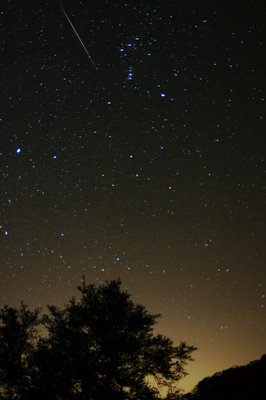I watched the peak of the Geminids meteor shower last-night/this-morning from the Bamberger Ranch, with the kind permission of the Bambergers. (They even threw in a slice of Margaret's birthday cake. Happy birthday, Margaret.) I setup a pair of the original Canon Digital Rebels, one with a Sigma 20mm, f1.8 lens, and the other with a Sigma 10-20mm, f4-5.6 lens set for 10mm and f4. Both were shooting RAW, manual-focused on infinity, set for ISO 400, and using a shutter speed of 30 seconds. They were aimed such that the field of view of the 20mm lens was entirely subsumed in the field of the view of the 10-20mm lens, set at 10mm. I shot about 270 frames with each camera, concurrently, but with the shutters staggered to try to avoid missing meteors while one or the other camera had its shutter closed.
From past experience, I knew the 20mm, f1.8 lens could capture some meteors. I had doubts that the 10-20mm would be of any use at f4. My first look at the results credits the 20mm, f1.8 lens with 8 meteors, and the 10-20mm at f4 with 4 meteors, even though it covered four times as much sky as the 20mm lens. So, the 10-20mm, f4-5.6 lens isn't completely useless for meteor showers, but it's a very poor choice for such work. Not much of a surprise there, but now I know.
The good news is that all of that driving, and those four hours of shivering and photography produced my best meteor photograph so far (taken with the 20mm, f1.8 lens, of course). That meteor wasn't the most spectacular of the 198 I counted, but it was a good one. The best of them all was really two meteors that entered at the zenith at the same moment, but going in precisely opposite directions. One burned-out quickly, but the other had a good, long run, and burned so bright against the black of the sky that it reminded me of seeing a thin ribbon of magnesium burn in a high school chemistry class.
One peculiar happening while I lay out there on the cold ground controlling the cameras and counting occasional meteors, was a sound off in the dark distance that I can only say made me imagine an angry hawk, expressing its anger in high-pitched wheezes. This sound came several times, then the usual quiet returned. It's quiet out there in a way that city dwellers, like me, may have a hard time grasping. There are no man-made sounds to be heard. Not even a distant hum of traffic on some highway. There's just the wind blowing through trees, and a few crickets. It takes a while to notice it, but it stands out in a big way once you do. So, the wheezing came from nowhere and then vanished into that amazing quiet. A minute or two later, the wheezing returns from the same direction, but closer. Soon, hooves are heard running on the hard ground, coming from that direction towards me. They seem to account for at least four animals, but what sort of animal, I can't figure. My untrained ears claim that the hoof-falls are too heavy to be deer, but too light to be cattle. The sound of the hooves seems to be ahead of the wheezing, which chases after them. The sounds come closer and closer and I begin to wonder if some panicked livestock are about to show-up and trample my cameras. Their eyesight and hearing are almost certainly better than mine, so they should know I'm ahead, but they keep coming anyway. Just ahead of that wheezing. I let out a quick whistle to try to ensure that they're factoring me into their plans. It doesn't seem to have any effect on their pace or course, but soon the hoof-falls stop, seemingly for their own reasons. Whatever was making them is nearby; I can hear them breathing hard, but can't see a thing. Their breathing dies away, and the quiet is beginning to settle in again when the wheezing returns, and then hooves are running again, but now parallel to me, and then away and out into the invisible grass, and the remarkable quiet.




Loved your description of the approaching sounds. This reminds me of my youth, laying out under the stars with my buddies seeing "Everything" and imaging going into space. Can't wait to read about your next adventure.
ReplyDelete